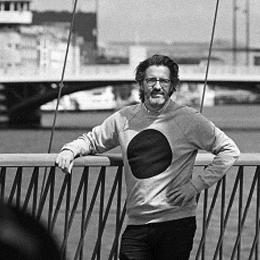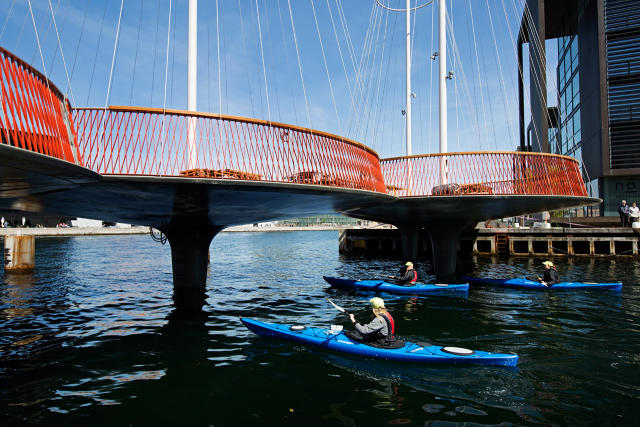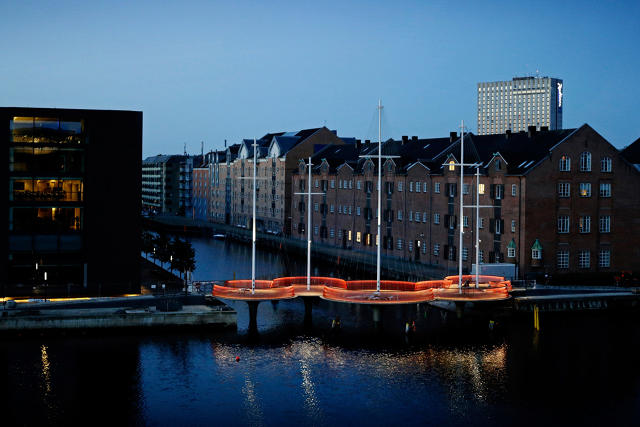From a distance Cirkelbroen (circle bridge) on Christianshavns canal in Copenhagen, Denmark, takes on the guise of illuminated ships. Created by artist Olafur Eliasson and set to open on August 22, the bridge is the last link needed to make the entire perimeter of the city’s harbor accessible to pedestrians and cyclists.
Along with Nordea Fonden—a Danish organization that supports healthful activities—the city commissioned Eliasson to build a special project that’s emblematic of Copenhagen’s spirit. “On one side, it’s a work of art that is significant for downtown Copenhagen,” Eliasson says. “But on the other side, it’s about making a contribution to Copenhagen’s signature of environmentally friendly outdoor activity.”
Pedestrian bridges have helped make cities more livable. Cirkelbroen does that and also reveals a narrative about how one of the world’s most respected artists views the role of public space in shaping our culture. Eliasson’s work explores the intersection of nature, science, and human perception. For example, his recent LEGO installation called Collectively invited viewers to recast the work of famous architects. He’s made cheese using his own tears. An installation at the Louisiana museum, in Copenhagen, recreated a riverbed indoors. His monumental Take Your Time exhibition, which traveled to multiple museums, engaged visitors in artworks that explored what it means to see and observe. Cirkelbroen expounds on those notions, but in the form of infrastructure.

Eliasson hopes the 128-foot-long bridge‚ which is illuminated at night, becomes a space for people to meet, slow down, take a break, and hesitate. Here, the artist talks to us about channeling Copenhagen’s maritime history; why art should be hard work; and why public spaces designed with pragmatism in mind are overrated.
Co.Design: Your previous architectural-scale projects have always been in collaboration with another firm, but you’re kind of like the architect of this bridge.
Olafur Eliasson: Yes, but I’ve always been focused on the design process. When I worked with other firms, I was always in charge of at least some part of the design. In this case, I was the main contractor, and I designed the project. It’s like a work of art that works in life.

Did you approach the bridge’s design the same ways you would for an installation?
To an extent I did. Fundamentally, I am an artist. I do not primarily focus on the function or the pragmatics of the situation. And my challenge here was to bring people from one side of the water to the other.
I was inspired by fishing boats I saw as a child in Iceland. In the harbor, they would sort of sit next to each other. To reach my father’s fishing boat, I would have to cross two or three other boats first. Sometimes, but not very often, you could cross the harbor just by walking over the boats.
Copenhagen’s harbor used to be a place with a lot of maritime activity, and I wanted to build a testimony to that. I wanted to create an impression of five small sailboats that created a bridge. This was how the first sketches started. On the other side, it was also clear to me that there would be a substantial amount of traffic, both from pedestrians and bicycles. It was calculated that on a busy day 4,000 people would cross the bridge. I was very interested in the the idea of what would I want the 4,000 people to do.
My next inspiration was to see if I could suggest that the bridge is not just a space of passing, but also a space of slowing down and taking a look—almost like a little square above the water where people could meet. You could almost give the bridge an urban quality, like people saying, ‘Why don’t we meet on the bridge?’ I thought that was a sweet and inspiring idea.

Was it challenging to reconcile the practicalities and function of a pedestrian bridge with the overall impression you wanted to create?
Well, no. As an artist it’s exciting to take on authority. I had a very good dialogue with the city planning department. They wanted to support the idea of having a strong signature that would contribute to the city’s downtown activity. I was interested in staying within the general rules because essentially a lot of the rules apply to making people’s lives easier, such as the bridge needing to be a certain height so the small boats that are so special to Copenhagen can actually go under the bridge easily. The pragmatics were more about keeping city life alive and in that sense. I didn’t want my artistic ideas to be seen as a compromise to the quality of life that’s so famous in downtown Copenhagen.
In thinking about Cirkelbroen in the context of providing a subtle space for contemplation and reflection—”room for thought”—is that an underlying theme of your installations?
Contemplation and reflection are general lines through a lot of my work, but I think it’s fair to say that we often categorize ‘contemplation’ and ‘reflection’ as something that is similar to being in a wellness spa where you feel free of demands—you are in a ‘demand-free’ zone [in a spa]. And this is not what I mean when I say reflection or contemplation; I mean it as a demand.
There is a demand that you make the effort to see yourself in the context of the situation you’re in. It could be a micro context: What does it mean when I’m sharing a space with another person? There could also be a macro view: How do I fit into the world, and how do my actions impact the global climate? Reflexivity is actually hard work.
Wellness is about losing yourself, disappearing, becoming. It’s about being numb, which can be very de-stressing, but only for a moment. Reflexivity is about connectivity, and connectivity is sometimes more about looking into yourself than looking at the ‘other.’ It can be hard work, and it can be uncomfortable, but sometimes public space has to make that demand of you. And sometimes art—and good art always—makes that demand of you. It makes you work. It makes you give. It makes you into a producer of space, of situations, of life, instead of being a consumer.
A wellness center is a consuming environment. You sit down—you probably pay a lot of money, too—and then you kind of take it all in whereas a robust cultural event actually makes you work. A theatrical play or a great concert makes you give from your heart, from your brain, in your spirit. This is why I think contemplation and reflexivity is something that is hard work.

What are the most important sensibilities that an artist can contribute to a public project or a public space?
This is a big topic. I think that we are coming to the end of an era where pragmatics were governing the organization and hierarchies of public space. There’s a general acceptance that the idea of something being public is not just a dogmatic idea. Something public means something more generic and performative—something that has a sort of agency.
For a public space to be truly public, it needs the confidence and trust of civic activity. This has opened up a lot of new ways of thinking about what the resources of public space are. Do we need to support the atmospheric ideas of a public space? What does a good atmosphere do? I’m generalizing a little bit by saying this, but I think there has been a shift in understanding that one cannot plan—in terms of city planning—atmosphere. Atmosphere is something that’s created by the people who use a space and generate spatial activity.
To nurture a space and its public hospitality, atmospheres must be allowed to grow. And suddenly, one looks at the people who specialize in atmospheric or abstract or emotional activities and of course this is the artist—the cultural activist.
To have a successful public space, you need to allow it to become a performative space or an evolutionary space. My experience is that there’s an increasing focus on needing an artist on board, maybe just as an advisor or a part of the team, or maybe as a designer. City planning has been way too pragmatic and functionally driven for a long time.

In the past, art in a public space might just mean a sculpture. Is the importance of an artist now in creating experiences versus an object to behold?
Some art can be representational or functional in the memory of a great legacy. This is also an artist’s agenda, but that’s not a city planning perspective. It’s more monolithic, and that’s fine and there should be space for that as well.
In terms of planning conditions, I think it’s important to ask: ‘Do we need our public space to reflect the values of our society?’ The challenge is to translate our idealistic dreams into how we organize our lives.
The translation between thinking and doing is the main exercise of an artist. It’s to combine thought with action. In terms of spatial activity—a non-verbal shaping of the world—the artist has a long tradition of looking at physical activity. What does a body in terms of scale do to a space? It’s difficult to generalize, but I think artists are perfect for the role.
Maybe the artist is the person who can allow for a process to shift back forth and who can think about our values when it comes to space. Do we want an inclusive space or do we want an exclusive space? Do we want to facilitate the meeting of two strangers, or do we want to prevent two strangers coming together? Is a stranger welcome?
Jahn Gehl and his studio, who did the Times Square and Broadway planning in New York, are well-established in thinking about the hospitality of space in regards to welcoming the unpredictable and facilitating a process based on the evolution of a space. The civic contribution is what makes a space hospitable.
What can the United States learn from Copenhagen’s relationship with its waterfront?
I’m very interested in the history and the contemporary idea of public space in America. There’s a slightly different tradition of what you would call civic infrastructure and civic trust in the country, because, to put it a little bluntly, what is public is what was left over when everything else was privatized. But this does not mean that there isn’t a strong civic infrastructure and a very robust civic trust.
I believe it’s worth it to have a strong regulative government system that makes rules about the rights of people on the streets. It plans the streets to facilitate the ability for people to express themselves—freedom of thought, freedom of expression, and so forth.
Very early on, Copenhagen made a lot of regulatory principles because it was both healthy for the civic infrastructure and healthy for the citizens to have parks. This is visible in America as well, but in America, public spaces are generally facilitated by privatized systems.
What it all boils down to, is does a society trust that abstract values, emotional values, creativity, and unpredictability belong in public space? Is our public space highly regulated, predictable, and about health and safety in terms of preventing people from being surprised? Does the space nurture the possibility of a surprise or is that too much of a risk? I find these questions very interesting.
There’s a tendency in America to plan to prevent surprises whereas in Copenhagen there is some stamina in city planning to actually plan for the surprise and for the unpredictable to happen. It’s not always the case—I’m definitely romanticizing a little bit about the planning authorities in Denmark—but generally I think there’s a strong tradition in believing that the public means believing in the idea of including the “other”—the idea that we have not had yet, the person we have not met yet, and the unpredictable encounter.
Cirkelbroen opens August 22, 2015. Visit nordeafonden.dk for more information. Follow @olafureliasson on Twitter, @studioolafureliasson on Instagram, and like his Facebook page to keep on top of the studio’s latest news.